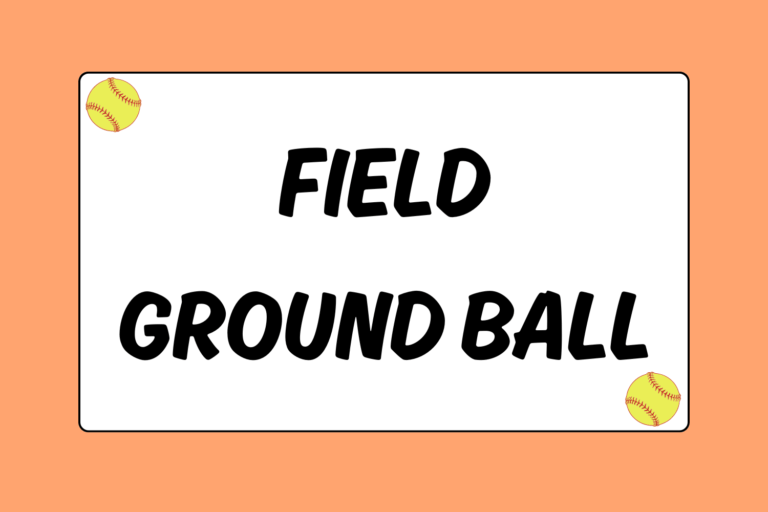On a fly ball that’s falling fast with the game on the line, you can’t let it drop. You might have to dive for it! If you’re tentative to go head-first into the grass, don’t worry — it’s easier than it looks. This softball guide will offer instruction on how to make a safe dive in the outfield. With enough practice, you’ll be making highlight-worthy dives in no time.
The Approach
When you approach a ball that’s descending quickly, you can’t simply sprint to the ball and then drop to the ground. That is a surefire way to get injured. You have to approach the ball gracefully, like an airplane landing.
As you approach the ball (and you should be sprinting), start lowering your body by bending your knees deeper and deeper with each step. With your last two steps, you will extend both arms towards the ball and lean your chest forward. On your last step before going fully into the dive, you will push off your glove-side foot. Then you’ll be airborne.
If you were to take frame-by-frame pictures of an outfielder diving for a ball that is dropping directly in front of her, this is what you’d see (for the purpose of this guide, the outfielder will be taking six steps before going airborne):
- The ball is in the pitcher’s hand: The outfielder is standing light on her feet.
- The ball is being released: The outfielder is taking two steps in towards the infield (starting with her throwing-side foot) and settling into her ready position.
- The batter makes contact with the ball: The outfielder drop steps in the direction the ball is hit. The first step is always back.
- The ball starts descending: The outfielder realizes the ball is coming up short and starts sprinting to the ball. Her glove is tucked.
- Her first step: She drives forward with her throwing-side foot, standing tall.
- Her second step: She drives forward with her glove-side foot, starting to lower herself by bending her knees.
- Her third step: She continues driving forward with her throwing-side foot, getting low.
- Her fourth step: She drives forward with her glove-side foot, getting even lower.
- Her fifth step: She is aggressively low as she strides forward with her throwing-side foot. Her arms are beginning to extend forward and her chest is starting to lean forward, making her slightly off-balance.
- Her sixth step: She takes a short, quick step with her glove-side leg. Then, with her body so low that her glove-side leg creates a 90-degree angle at the knee and her hamstrings are perfectly parallel to the ground, she propels herself forward off the ground. Her arms are fully extended. She is airborne.
- She catches the ball: Her glove is always below the ball.
Hot Tip: Beginning Diving Drills
When you’re learning how to dive, it can be scary! To conquer your fear, here are two drills that will help you build confidence in your diving abilities:
- Have a partner stand about 10 feet in front of you. You should start on your knees with your torso lifted off the ground (thighs perpendicular to the grass). Keep the balls of your feet on the ground, so your toes will be curled. Have your partner toss the ball straight in front of you and to your sides. React by diving off your knees.
- Start in center field with a hitter on one of the foul lines. She will hit you a grounder. Field it like a do-or-die grounder. Once you throw the ball in, the hitter will immediately throw you a short pop-up. With your momentum coming forward, go smoothly into the dive.
If you’re fairly new to the sport, make sure you are wearing your knee pads!
Move Your Glove
There isn’t too much of a difference between diving for a ball that is dropping right in front of you, and diving for balls hit to your sides. You will take the same approach and sprint to the ball, but you will need to angle your glove differently, depending on where the ball is. You will also need to dive at an angle to the ball:
- The ball is directly in front of you: Catch the ball out in front of you. The web of your glove and your fingers will be underneath the ball, pointed forward.
- The ball is to your left: When the ball is hit to your left, take the same approach. When you stick your arm out to catch it, turn your wrist so your palm faces the ball. You’ll catch the ball with the web of your glove behind and underneath the ball. Your pinky will be about parallel to the ground and below the ball.
- The ball is to your right: When the ball is hit to your right, the approach does not differ. When you stick your arm out, turn your wrist so your palm faces the ball. Your thumb will be about parallel to the ground and below the ball. The web of your glove should be behind and underneath the ball on the catch.
To Dive or Not to Dive
You should dive when you need to, but be aware of certain situations when perhaps you shouldn’t. For example, if the game is on the line and there is a runner on second with less than two outs, do not dive if she is fast. Let it drop and run in to field the ball, keeping your eyes on the runner. That way, you can hold her at third. If you see her going home, you’ll be able to set yourself up to throw her out. If you were to dive, you’d have to get up, and then take a few steps forward to crow hop and set yourself up for the throw. You have to be smart. With two outs, go for it! With less than two, be wary.
Can o’ Corn!
With enough practice, you’ll start getting comfortable with your dives. Just remember to only dive when you need to. If you know you won’t be able to catch it, don’t bother diving, because it will take much longer to get up and chase down the ball. Similarly, if you’re lollygagging to the ball and want to dive just to show everyone that you can, it will hardly be a standout play.
Always practice as you’d play. If your teammate hits a low line drive, go all out for it. If you don’t do it in practice, you won’t do it in a game. Get out there and get dirty!





